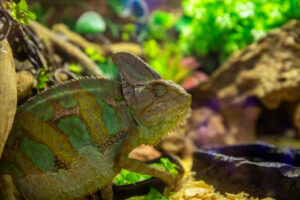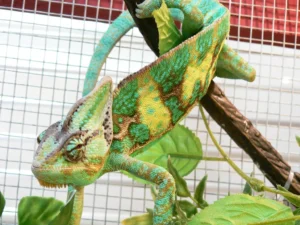Greetings fellow chameleon enthusiasts! Today, let’s embark on the essential journey of maintaining a clean and healthy environment for our vibrant companions. As any responsible chameleon owner knows, ensuring a pristine living space is crucial to your pet’s well-being.
In this article, we’ll delve into the art of chameleon cage cleaning, exploring effective techniques and valuable tips to create a habitat that promotes both physical and mental health for these mesmerizing reptiles.
So, let’s get on the adventure as we uncover the secrets of “How to Clean a Chameleon Cage” and elevate the quality of life for your scaly friends.
How to Clean a Chameleon Cage

Cleaning a chameleon cage is crucial for maintaining a healthy and comfortable environment for your pet. Here are step-by-step instructions on how to clean a chameleon cage:
Materials Needed:
- Mild dish soap
- Water spray bottle
- Paper towels or a soft cloth
- Bucket or basin
- Vinegar (optional)
- Gloves (optional)
Steps:
- Remove Your Chameleon:
- Gently transfer your chameleon to a temporary holding container, ensuring it’s safe and secure. Use a small enclosure or a reptile transport container.
- Remove Accessories:
- Take out all decorations, branches, rocks, and any other cage accessories. Clean these separately in a sink or basin with mild soap and water.
- Dispose of Substrate:
- If your chameleon’s cage has a substrate (like bark or coconut fiber), remove and dispose of it. Vacuum or wipe the bottom of the cage to remove any loose debris.
- Clean Cage Walls:
- Wipe down the walls of the cage with a water spray bottle or a damp cloth to remove any dust or residue. If needed, use a mild soap solution, but ensure it’s thoroughly rinsed to avoid chemical exposure to your chameleon.
- Clean Perches and Branches:
- Scrub perches and branches with a soft brush or cloth using mild soap and water. Rinse thoroughly and allow them to air dry.
- Clean Cage Furniture:
- Clean any other cage furniture or decorations using the same mild soap and water solution. Rinse well and allow them to dry completely.
- Disinfect with Vinegar (Optional):
- If you want to disinfect the cage further, you can mix a solution of one part white vinegar to one part water. Spray the solution on the cage surfaces, leave it for a few minutes, and then wipe it off. Ensure the cage is thoroughly rinsed to remove any residual vinegar.
- Clean Water and Food Bowls:
- Wash your chameleon’s water and food bowls with mild soap and water. Rinse them thoroughly before placing them back in the cage.
- Replace Substrate:
- If you use substrate, add a fresh layer to the bottom of the cage once it’s completely dry.
- Return Accessories:
- Put back the cleaned and dried branches, decorations, and any other cage accessories.
- Return Your Chameleon:
- Once the cage is completely clean and dry, carefully return your chameleon to its habitat.
- Regular Maintenance:
- To keep the cage clean, establish a regular cleaning schedule. Remove waste and spot clean as needed, and perform a more thorough cleaning on a regular basis.
Always prioritize your chameleon’s safety and well-being during the cleaning process. Be gentle and observant, and make sure the cage is completely dry before returning your chameleon to avoid any health issues.
How often should I clean my chameleon’s cage?
The frequency of cleaning your chameleon’s cage depends on various factors, including the size of the enclosure, the substrate used, the number of chameleons, and your chameleon’s habits. However, here are some general guidelines to help you establish a cleaning schedule:
- Daily Maintenance:
- Spot Cleaning: Remove feces, shed skin, and any leftover food daily. This helps maintain a clean and hygienic environment for your chameleon.
- Weekly Cleaning:
- Change Substrate (if used): If you use a substrate in the cage, consider changing it weekly to prevent the buildup of waste and bacteria.
- Wash Accessories: Clean and sanitize accessories, such as branches, perches, and decorations, on a weekly basis.
- Bi-Weekly to Monthly Cleaning:
- Full Cage Cleaning: Perform a more thorough cleaning of the entire cage, including removing your chameleon temporarily. Clean the cage walls, furniture, and other accessories. Disinfect if necessary, but ensure that the cage is thoroughly rinsed before reintroducing your chameleon.
- Observational Cleaning:
- Pay attention to any signs of mold, mildew, or excessive bacterial growth. If you notice any of these issues, clean the cage immediately.
- Water and Food Bowls:
- Clean and refill water and food bowls regularly, ideally on a daily basis, to ensure a fresh and clean water supply.
It’s essential to observe your chameleon’s behavior and the condition of the cage to determine if more frequent cleanings are necessary. If you have multiple chameleons sharing an enclosure, you may need to clean more often to maintain a healthy environment.
Regular maintenance and cleaning not only keep your chameleon healthy but also allow you to monitor its behavior and detect any potential health issues early. Adjust the cleaning frequency based on the specific needs of your chameleon and the conditions of the cage.
Can I use regular cleaners for the cage?

It’s generally not recommended to use regular household cleaners for your chameleon’s cage. Many household cleaners contain chemicals that can be harmful or toxic to reptiles. Chameleons are particularly sensitive to chemicals and residues, and exposure to such substances can have adverse effects on their health.
Instead of regular household cleaners, consider using more reptile-friendly cleaning options:
- Mild Soap and Water:
- A mixture of mild dish soap and water is often sufficient for cleaning the cage and its accessories. Ensure that you rinse thoroughly to remove any soap residue.
- White Vinegar:
- White vinegar diluted with water can be used as a natural disinfectant. Mix one part white vinegar with one part water and apply it to the cage surfaces. Rinse thoroughly after a few minutes to remove any residual vinegar.
- Reptile-Safe Cleaners:
- Some pet stores offer reptile-safe cage cleaners specifically designed for cleaning reptile enclosures. These products are formulated to be safe for reptiles and their habitats.
When cleaning, be sure to remove your chameleon from the cage to prevent direct exposure to cleaning agents. Thoroughly rinse and dry all surfaces before reintroducing your chameleon to its habitat.
Avoid using cleaners with strong fragrances, bleach, ammonia, or other harsh chemicals, as these can be harmful to your chameleon. Always prioritize the health and well-being of your pet when choosing cleaning products for their enclosure.
Best substrate for easy cleaning
The choice of substrate for a chameleon enclosure depends on the specific needs of the species and the ease of maintenance. Here are some substrate options that are relatively easy to clean and maintain for chameleon cages:
- Paper Towels/Newspaper:
- This is a simple and easy-to-clean substrate option. Place several layers of paper towels or newspaper at the bottom of the cage. When soiled, simply remove and replace with fresh layers.
- Reptile Carpet/Liners:
- Reptile-specific carpet or liners made of synthetic materials are easy to clean. They can be removed, washed, and reused, providing a comfortable surface for your chameleon.
- Bioactive Substrates:
- Bioactive substrates, such as coconut coir or a mixture of organic materials, can create a more natural environment for your chameleon. While they require less frequent replacement, the maintenance involves spot cleaning and occasionally adding beneficial microorganisms.
- Bamboo Bedding/Paper-Based Substrates:
- Beddings made from shredded bamboo or paper-based materials are absorbent and easy to clean. They can be spot cleaned daily, and the entire substrate can be changed periodically.
- Exo Terra Plantation Soil:
- This substrate is made from compressed coconut husk fibers and is suitable for tropical terrariums. It holds moisture well and is easy to spot clean. It can also contribute to the humidity levels in the enclosure.
When using any substrate, it’s essential to monitor humidity levels and cleanliness regularly. Spot cleaning should be performed daily to remove feces and any uneaten food, and the entire substrate should be replaced or cleaned periodically.
Avoid substrates that can be ingested by your chameleon, as this can lead to impaction. Additionally, ensure that the substrate doesn’t retain excessive moisture, as high humidity levels can contribute to bacterial and fungal growth.
Ultimately, the best substrate for easy cleaning depends on your chameleon’s specific needs, the humidity requirements, and your preference for maintaining a clean and healthy environment.
How to sanitize and disinfect cage items?
Sanitizing and disinfecting cage items is crucial for maintaining a clean and healthy environment for your chameleon. Here’s a step-by-step guide on how to sanitize and disinfect cage items:
Materials Needed:
- Mild dish soap
- Water
- Soft brush or cloth
- White vinegar (optional)
- Bleach (optional)
- Bucket or basin
- Gloves (optional)
Steps:
- Gather Accessories:
- Collect all cage items, such as branches, perches, decorations, and any other items that need cleaning.
- Remove Debris:
- Shake or brush off any loose debris, feces, or dirt from the items before cleaning.
- Wash with Mild Soap:
- Fill a bucket or basin with warm water and add a small amount of mild dish soap. Use a soft brush or cloth to scrub the items thoroughly. Pay attention to any crevices or textured surfaces.
- Rinse Thoroughly:
- Rinse each item under running water to remove soap residue. Make sure all surfaces are thoroughly rinsed to prevent any potential harm to your chameleon.
- Optional Vinegar Disinfection:
- For a natural disinfectant, mix one part white vinegar with one part water. Apply this solution to the items and let them sit for a few minutes before rinsing thoroughly. Vinegar has mild disinfectant properties.
- Optional Bleach Disinfection:
- If you prefer a stronger disinfectant, you can create a diluted bleach solution. Mix 1 part bleach with 10 parts water. Soak the items in this solution for 10-15 minutes, then rinse thoroughly. Ensure that there is no residual bleach left on the items.
- Air Dry:
- Allow the items to air dry completely before returning them to the chameleon’s cage. Ensure that there is no moisture left on the items, as a damp environment can promote bacterial growth.
- Check for Residue:
- Before returning items to the cage, double-check for any cleaning product residue. Residues from cleaning agents can be harmful to your chameleon.
- Regular Cleaning Schedule:
- Establish a regular cleaning schedule for cage items to prevent the buildup of dirt and bacteria. The frequency may vary depending on the specific needs of your chameleon and the size of the enclosure.
Always prioritize the safety of your chameleon when using cleaning agents. Rinse items thoroughly to remove any cleaning product residues, and allow them to dry completely before reintroducing them to the cage.
Any cleaning products to avoid?


